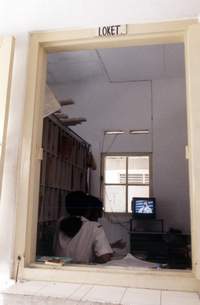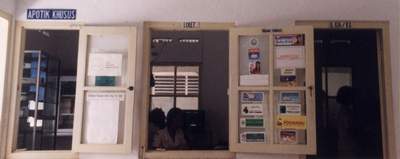|
“I’m scheduled to get my shot today, Mrs.
Doctor,” said the old man, his shiny dark face peering through the door of the
Puskesmas—short for Pusat Kesehatan Masyarakat or Community Health
Center—where I worked in Tabanan, Bali.
“What’s wrong with you, Sir?” I asked
him as he took a seat.
“Nothing, really. The shots are so I feel fresher.
You’re new here, right? I’m a regular at this clinic,” he informed me,
appearing to grow impatient with my idiotic question. As I let loose a whole series of
queries designed to gauge the state of his health, he got up from his chair and gazed out
the window, seeming to search for someone less dim-witted than this bespectacled woman
doctor.
“You’re a new doctor, right?” he finally
concluded.
Five years have passed since that day. In
those years, I’ve learned a lot, including the fact that most people in our community
don’t like being asked—at least by doctors—about the ins and outs of their
health. The longer such interrogations last, the more light they shed not on the
patient’s condition but on the extent of the doctor’s stupidity. After all,
traditional healers don’t feel the need to ask their patients about their family
history, past medical history, allergies, diet or weekly exercise routine. What a waste of
time! As one of my patients once reprimanded me, “Get to the point, Doctor!”
It would be misleading, of course, to
claim that every Indonesian feels this way. A small number of people hold the opposite
view, giving credit to doctors who quiz them at length. “Doctor, you’re so
thorough!” they praise. And others who don’t like to engage with their doctors
on issues of their health are nonetheless eager when invited to converse on other topics.
Ask them about their business, their boyfriend or girlfriend, the price of rice, the
rising cost of fuel, or the problem of traffic and they’ll be happy to chat.
They’ll even recommend you to their friends, reporting that their doctor is a very
friendly person.
I made my way to the senior doctor’s office to
discuss the matter of an elderly man claiming it was his scheduled injection day. I had no
idea what kind of injection to give him, what ailed him, or what he meant by
“scheduled injection.” As I recounted the case, the head doctor alternated his
gaze between a Mexican soap opera and his plate of fruit salad, and then he turned away to
draw the curtains closed.
“Just give him vitamin B12. He’s a regular
patient of this Puskesmas,” the doctor instructed two white-gowned nurses, who were
engrossed in the struggles of a poor girl in Mexico City.
“But Doctor, what’s his condition?” I
remained in the doorway despite the very clear instructions and the body language that was
obviously telling me it was time to leave.
“Come on, why so serious?” the doctor chided
me, leaning over to open a plastic bag of bright red coconut pancakes.
Idealism unvanquished, I returned to the treatment room
to find the old man had already raised his sarong and readied his backside for my needle.
His eyes were closed, and his hand clenched the edge of the chair.
“I’m ready, Doctor!” he announced.
“Sir, before I inject you, come on, let’s
talk a bit first,” I insisted. “What exactly is ailing you?” This was the
second time I had asked him that question.
“Come on, Mrs. Doctor. I’m a regular here.
When did you get here? And you’re young. Just ask one of the other doctors. Everyone
already knows about my medicine.”
Full stop. Deadlock.

I went to the cupboard where the syringes and needles and vibrantly-colored vials of
vitamin B12 were kept. One eight-milliliter vial of vitamin B12, minus its lid,
stood beside two used three-milliliter syringes. I stuck my head further inside the
cupboard to look for a clean syringe. Then I turned to the next cupboard, just in case
that grimy space was being used to store medical supplies. Unfortunately not. I ran to
find the nurses, and found them actually sobbing as the story unfolded on the screen.
“Excuse me, where do you
keep the syringes?” I asked, standing in the doorway. Luckily the commercial break
had begun. At least my presence wouldn’t be disturbing their mental enrichment
program.
“There are some in the
rack, aren’t there? In the same place as the vitamin B12. We put them together in
kits,” explained the nurse, running her fingers through her newly-permed hair.
“Which rack would that
be?” I asked.
The nurse, who clearly felt that this transformed coiffure had greatly improved her
appearance, smiled sweetly, slithered out of her seat, took my hand and led me to the
medicine cupboard.
“What’s this?”
she scolded, chuckling victoriously as she gestured toward the used
syringes.“You’re too impatient, Doctor! How could you possibly not see a thing
this big?”
“Yes, I did see this. But
where are the fresh syringes? And this needle has been used,” I pointed out.
“Yes, that’s it, the
needle for injections.” It seemed she had little clue what I was talking about. I
don’t need to continue this story. Clearly the matter of used syringes that had been
sitting in a cupboard for who knows how long, and had been used on who knows how many
backsides, was of no interest to her whatsoever. As a look of total surrender washed over
my face, the permed nurse finally seemed to pity me.
“If you’d like to
clean the syringe with alcohol, we have lots of alcohol here,” she said, directing me
to two bottles standing on a shelf.
“So never share needles,
especially among young people, and don’t be enticed into sinful behavior like using
drugs, free sex and drinking alcohol. Those are the ways of Westerners and we needn’t
follow their example. Moreover, now that AIDS and Hepatitis B are rife, you must never
share needles!” So went the lecture of the Puskesmas doctor. It was 11 a.m. and the
Puskesmas had organized an educational talk for local residents. The audience nodded their
heads. The old man who had come first thing in the morning for his injection was also
present. He was grinning broadly, showing his firm grasp of what was being said.
This was my first official day
as a resident in the public health clinic. All the theory that I had learnt in eight
semesters of medical school seemed to fade in the face of practical reality. Over and over
again, I asked myself whether I had done something wrong. Why did the doctors and the
nurses regard me as some strange creature? Why were they laughing at my idealism? Why were
they making me feel as if my knowledge was worthless and inferior, having nothing to do
with being a real doctor? Later that night, I broke down in tears.
My parents knocked at the door
of my room. My mother appeared with hot tea and fried bananas. My father stroked my head.
“Only a few more
months!” he consoled, adding a hearty “Hang in there!”
Strangely, after feeling so
depressed, the next day I woke with a new spirit. I enthusiastically headed off to the
clinic, thirty kilometers from my house. My mother had changed the oil in my motorbike the
night before. My father had polished the black Honda Astrea’s body. It made me sad to
see them express their hopes in this indirect way—their hopes that my public health
residency would not be undone. I was touched to see them polishing the spokes of my
motorbike until they gleamed. They chose not to discuss my discontent of the previous day,
but by caring for the vehicle that would take me once again to the clinic, they showed me
how high their hopes were for my eventual graduation.
“There will be an
inspection today!” said the nurse as soon as I arrived.
"An inspection from
where?” I asked.
“We have to get
ready!” she said, ignoring my question. Extraordinarily, that morning the television
was off. All the clinic staff were sitting at the table with long rulers and colored
marking pens and sheets of paper, their eyes cast upwards in thought. My presence seemed
to be of little consequence. I stood there for half an hour, marveling at how changed the
clinic seemed from the day before. Everyone was silent, fiddling with their rulers and
markers and charts until…abracadabra! They handed their papers to the head doctor. He
deftly pinned the fifteen sheets up on the clinic bulletin board. The papers bore the
following information:
1.Numbers of women who die in
childbirth
2.Scope of immunization
program for under-five year olds
3.Family planning acceptors
I remember being especially
impressed by the figure for immunization of under-five year olds. “Wow, 98%, nearly
100%!” I exclaimed.
“Hush, don’t
exaggerate too much,” the woman who ran the immunization program scolded. “If I
write 100% it’ll be too obvious. I’ll just put 98%.”

The next round of preparation
for the inspection involved women running off to the corner food stall to buy a whole load
of freshly made snacks. Several others went off to the kitchen to boil some water for
tea—super sweet, tealeaves adrift. The inspector came. The remainder of the program
involved eating. Drinking tea. Chatting about this and that. Exchanging forced smiles.
Being hospitable. We were reassured that the report of the inspection would be very
positive, excellent even. In other words, I should learn and follow their example. After
the inspector left, the situation returned to normal. The television came back on and
Maria Mercedes resumed her sobbing. With everyone else so happy that the inspection had
been deemed successful, I took the opportunity to talk with one of the nurses about the
injection episode—the episode that had made my life hell the previous day.
The Puskesmas, she explained,
was allotted five clean syringes per day. Three of them, however, were stolen by corrupt
staff, leaving only two—one of which I must use to carry out our elderly
client’s daily “scheduled injection.” Usually the nurses and doctors who
work at the Pusekesmas in the morning see patients privately in the afternoon. The doctors
seemed, for the most part, to be far more enthusiastic about their more profitable
afternoon practices—and many of the patients did too. One morning I met a man at a
food stall near the Puskesmas who appeared very ill. He reassured me he that was going to
go to the doctor later on that day.
“Why not be seen now? The
doctor is in at the Puseksmas,” I said with attempted conviction.
“I can’t be
bothered. They have different medicine there. You only get the real medication if you go
to the private clinic!” he told me, asking for assurance that I would not tell the
clinic staff what he had said. It was true that the Puskesmas followed different
standards for prescribing medication than those I had learned in medical school.
Antibiotics were almost always prescribed for three days only. When I protested, the
chemist pleaded with me to be realistic. The amount of antibiotics received by the
Puskesmas every month was far less than what was needed. But silently I always wondered
why every patient who complained of a sore throat and every child who came in carried on
her mother’s hip was loaded down with antibiotic powders and prescriptions. I
learned even more about medications the day a half-kilo bag of white pills turned up on my
desk. There was nothing on the bag to identify what its contents might be. I went down to
the chemist and asked him, “Sir, what are these pills? And who are they for? How is
the patient supposed to know what kind of medication they’re taking if it
doesn’t come with any identification?”
“You’re new here,
Doctor. I’ve been here for a long time and I know all the names of the medications by
heart. You need more experience! It’s not that hard to know what’s what. After
all, we only have twenty different kinds of medication.” But wasn’t the
medication for the patients? Didn’t they need to know what kinds of drugs we were
prescribing them? The very friendly chemist assured me that the majority of his customers
didn’t want to be blinded with science. They came to the Pusksemas because they
wanted to be cured, not because they wanted to learn the names of
medications—especially not the long and convoluted names drugs seem to go by
nowadays! That would only put their heads in a spin!
Indeed I found it true that,
in general, patients felt that the more medication they had to take, the quicker they
would be cured and the better they would feel—especially if that medication came in
the form of colorful pills, and most especially if it came in the form of modern-looking
capsules. Nearly every patient, no matter what their illness, went home with at least
three different kinds of medication. Patients who complained of a headache, for example,
were sent home with three packages: one containing antalgin (headache tablets), the other
vitamin B and a third vitamin C. Most likely, they would also have been given an injection
of vitamin B12. These medications seemed to make the patients feel better—even if
they didn’t cure them of their problems—and they seemed to make the doctors and
nurses feel that they had served their patients well.
The Puskesmas doctors were
also reluctant to break up their patients’ love affairs with injections. A friend of
mine once even suggested that this “love affair” was a key to healing. If the
patients really believe in the magical power of injections, why don’t we just give
them what they want? Not only does it encourage them to come to the Puskesmas where their
health can be checked, there’s no harm in injecting somebody with vitamin B12. In
fact, the converse is true—it can be good for the body. But what of AIDS, Hepatitis
B, and other diseases that can be spread through contaminated needles? It seemed I still
had a lot to learn.
Injil Abu Bakar is a
physician who lives in Denpasar, Bali.
|
 Latitutes
15 -- April 2002
Latitutes
15 -- April 2002